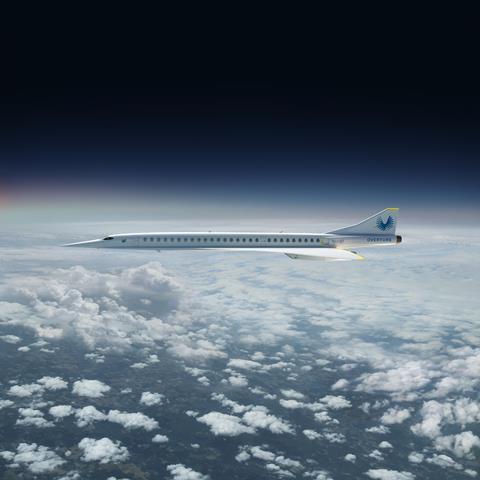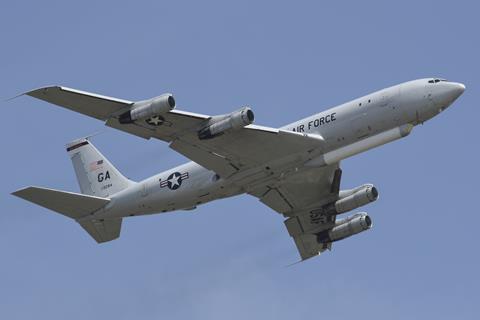The Mitchell Institute is calling on the US Air Force (USAF) to consider using in-development supersonic business jets as next-generation command and control aircraft.
The think tank believes supersonic aircraft, such as those being developed by Boom Supersonic or Spike Aerospace, may have advantages on the battlefield, its executive director Douglas Birkey writes in a policy paper titled Command and Control Imperatives for the 21st Century.

Boom appears to be the furthest advance in the race to develop a supersonic business jet. The company claims its Overture supersonic business jet will have a range of up to 4,250nm (7,900km) and the ability to fly at Mach 2.2. The jet would have capacity for 65 to 88 passengers. The company is aiming to have the aircraft ready to carry passengers by 2029.
The supersonic business jet industry is not assured, however. Startup Aerion, backed by Boeing, recently ran out of cash and ceased operations, it announced on 21 May.
Uncertainty around the future of supersonic business jets put aside, the Mitchell Institute sees military applications. The aircraft ought to be able to carry command and control, communications, and even intelligence, surveillance and reconnaissance (ISR) equipment, as well as a small air battle management crew. The aircraft could be an important node in the USAF’s next-generation battlefield network, known as the Advanced Battle Management System (ABMS), according to the paper.
“These aircraft will have significant speed, altitude, and survivability advantages that should expand the types of mission profiles they can fly, increase the reach of their sensors, and markedly reduce their risk of a shoot-down,” the paper explains. “In addition to reducing transit times in a large region such as the Pacific, flight at sustained supersonic speeds will allow ABMS effects to be delivered in a more responsive, agile fashion with a given number of aircraft.”
The USAF is already considering, and to a limited extent funding development of, supersonic aircraft for government executive transportation missions. In that role, supersonic aircraft would be used much in the same way the corporations use business jets: to save important decision makers time.
The Mitchell Institute envisions supersonic aircraft using their high cruise speed and long range to quickly get to far flung areas of interest – capabilities particularly useful over the vast ranges of the Pacific Ocean where the USA is facing off against China.
“This would allow more time on station by spending far less time transiting to and from basing locations,” the paper says. “This would also allow the use of bases far removed from the reach of enemy offensive systems, while not placing further demands on finite ramps in key operational centres of gravity. Locations like Anderson Air Force Base in Guam have limited room.”
Supersonic speeds also might allow these aircraft to dodge enemy fighters and surface-to-air missile batteries.
“An aircraft operating at supersonic speeds adds complexity to an adversary’s ground-to-air and air-to-air defences,” the paper explains. “Add this to the high altitude at which these aircraft operate – over 60,000ft – and the size of the effective enemy defensive threat rings reduce markedly.”
Supersonic business jets would not be immune to missile threats, but speed would reduce risk, as compared to conventional USAF subsonic military aircraft, which are derivatives of commercial airliners.
By operating at 60,000ft, on-board ISR sensors may also be able to see further, the paper adds.
Co-location of sensors with battlefield management also lessens the possibility of losing connectivity to off-aircraft ISR equipment that is part of the larger battlefield network.
“Hard wires and optical fibres connecting sensors to [command and control] workstations are very difficult to defeat,” the paper says.

The USAF’s current battle management and ISR aircraft, the Northrop Grumman E-8C Joint Surveillance Target Attack Radar System (JSTARS), is based on the Boeing 707-300 commercial airliner. That aircraft typically flies its missions at around 510kt (945km/h), and carries a flight crew of four and 18 mission specialists, according to the service. It is pondering ways to replace JSTARS, including dispersing bits and pieces of the aircraft’s command-and-control work across a network of aircraft and ground stations.
A previous, cancelled effort to replace JSTARS shows that using computers to perform many of the aircraft’s functions could be automated and handled by a crew small enough to fit inside a conventional business jet, points out the Mitchell Institute paper.
“Such trendlines will continue, which would afford a streamlined approach to on-board air battle manager manning requirements,” the paper says.
Birkey adds that conversations with technology developers lead him to believe that there are new ISR technologies that could be fitted into a supersonic aircraft’s streamlined fuselage. Currently, a radome protrudes from under the forward fuselage of JSTARS. Inside that radome is the aircraft’s powerful APY-7 active electronically scanned array side-looking radar antenna, which is used for battlefield surveillance.
The policy paper adds that some command-and-control work, not conducted on the supersonic jet, could be outsourced to air battle managers stationed on in-flight refuelling tankers, such as the Boeing KC-46 Pegasus.































